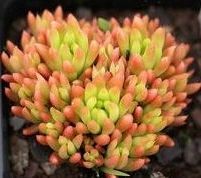Orostachys chanetii
(Orostachys chanetii)

Description
Orostachys is a genus of the succulent family Crassulaceae (stonecrop family) that contains about 15 species. It is a biennial herb growing in China, Japan, Kazakhstan, Korea, Mongolia, Russia. Eight species occur in China. Orostachys are the most morphologically distinct member of subfamily Sempervivoideae. Orostachys species are mostly biennial herbaceous plants that are more or less succulent. Leaves are linear to ovate, often with dull purple dots. The arrangement is alternate, forming crowded cauline rosettes. Especially the thick-fleshed foliage stores water. The leaf ends have a cartilaginous to spiny, white tip. Leaf margins are usually smooth. Stipules are absent. The roots are fibrous and there is no rhizome. In the first year, the leaves stand together in solitary, basal, dense rosettes. In the second year, a solitary, leafy stem, 5 to 60 cm in length, arises from the center of the rosette and forms flowers. The terminal inflorescences, usually branched and composed of individual spicate inflorescences, are relatively large and narrowly pyramidal to cylindrical, containing many flowers and foliage-like bracts. The flowers, which are at most very short-stemmed, are hermaphroditic and pentamerous. The free sepals are usually shorter than the petals. The five predominantly yellow, rarely white, yellow-green, or pinkish to reddish petals are almost free. There are two circles with five stamens. The yellowish nectary scales are relatively small. The erect carpels are free and contain many ovules. The styles are narrow. The many-seeded follicles possess a beak-like end. The seeds are small.
Taxonomic tree:







